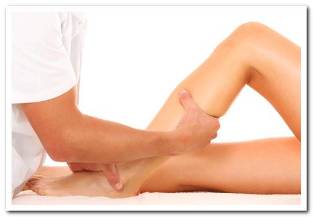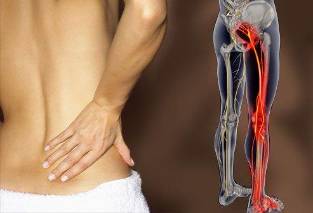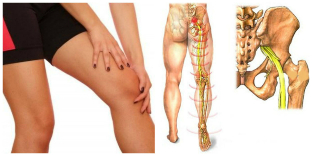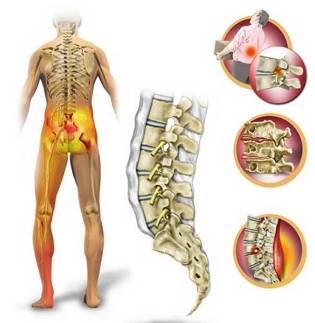This type of pain prevents no living simply, but even to walk. How is it that the pain irritation back, is able to penetrate into the finitude and lead to lameness? Although the source is much higher, we feel his influence over such a large distance: the back pain, but was numb and dragging their feet. How pain in the back in the foot?

The causes would make the pain in the legs may be a current of air, low back pain, hernia, tumors, and stress
This occurs through the nervous reflex of the nature of the pain, its capacity to spread over the entire length of the nerve exiting the spinal cord. If this nerve somewhere, irritates, occurs the reaction.
One of the possible causes of the pain in the legs can be an inflammation of the sciatic nerve
Lumbosacral department is the texture of the nerve fibers that come out of the vertebrae l4, L5 and S1 — S3. This is the plexus called the sciatic nerve. Leave the muscles a pear-shaped, literally, it branches on the thighs and ankle muscles and the joints, being the most powerful and the longest nerve in the human body.
The inflammation of the sciatic nerve thus responds in the lower limbs. The pain, which appeared in the back and between the legs, called lumbosciatica. Suffers usual (wrong or pulls) one foot on the side of the nerve, but it happens-and double-sided reaction, during which the two sore feet.
The pain is not limited to and the patient pursue other unpleasant sensations
- The feet scandal, lost their sensitivity, shooting, or numb
If the affected nerve at the level of the sacrum, with the participation of the glutes and thighs, pain syndrome of the sacrum and to the foot called sciatica.
Very often, people will share the pain in the back and the leg in two different categories and see not the first cause. "I have a pain in right knee, numbed by the foot. I can't walk on foot and climb up the stairs," — that describe the status of its members, forgetting the pain in the back, everything that has preceded it. Surprised also of the "incompetence" of the physicians, who, instead of treating osteoarthritis of the knee, all of a sudden begins to care for the spine.
But it is the backbone of its complex nervous, muscular-ligament and vascular is the cause of the sciatica.
Why the evil, pull and legs are numb
- Normal, the current of air can be the cause of wind in the back, the releases in the foot. The same consequences can result in a seat on a cold surface, bathing in cold water, and similar reasons. All of them can be grouped together under the term "supercooling"
- Osteochondrosis dystrophic the degenerative process in the sacred division also regularly leads to pain acute, that in the branch. The reason of them — the deformation of the disc affecting the nerve fibers and inflammation
- Education propulsion and intervertbral hernia can cause the syndrome of the pain is very intense, it is compression of the nerves. Pulse of pain spread over the area of innervation of the speed of the current. It is interesting that the sensation on the affected side also remind us of the symptoms of lesions of low current: Tingling, stinging, swarm of chills, sensation of cold. These symptoms are called paresthesia. If the legs are no longer painful, but just become numb, this may mean that, due to the long compression of nerve fibers, they have started the process atrophic
- Other diseases (ankylosing spondylitis, spondiloarthrosis, spondylolisthesis) leads to a restriction of mobility and stagnation in the tissues, bone, muscles, nerves and blood vessels, which promotes the inflammatory process
- Tumors of the spine, and tuberculosis can also cause inflammation of the sciatic nerve and the feeling that pulls and eats in the states
- Stress is not a trivial phenomenon and will never pass unnoticed, especially where there are involved the nerves
The classification of the pain of the back and legs

The origin of all types of back pain, spreading to the extremities, one can coarsely define three main groups:
- The first relates to neuroreflex the nature of the pain and pathological processes in the spine.
Here you can put all the DCF (degenerate-dystrophic processes), due to which are violated all the metabolic processes in tissues and their nutrition, as well as infectious diseases, inflammatory diseases, and congenital dysplasia of the spine. The threat of nerve fibers that is here double:
- They are exposed to direct mechanical abrasion of the part links of the spine
- Changes begin to occur in the nerve fibers
- The second muscle group related to dysfunction in the back or the legs. The causes in turn are different. It is:
- Scoliosis of the spine, which is formed resistant asymmetry of muscle groups, located on both sides of the arc
- The increase of the load on the muscles, result in an uncomfortable posture or physical surge
- Muscle myositis caused by hypothermia, infectious disease processes, or pathologies, congenital
- The pain in the legs is often quite banal to reason — walking in high heels the Reason for the pain in the legs can become uncomfortable high-heeled shoes
- Vegetative dysfunction — the third type of origin, the sciatic
Vegetative-visceral of the breach is enormous syndrome, which includes all of the irregularities in the functioning of internal organs and body systems related to impaired adjustment of the autonomic nervous system (ANS)
Vegetative system is closely linked to a centre on the principle of right and of the feedback:
- The failures in the central nervous system, damage to the spinal nerves and the fibers lead to disruption of the BNB
- Vegetative violations of the response to nerve of the central nervous system, in the area of the innervation of which they are
Especially often experience foot problems that can occur when vegetative-vascular violations in the area of the lumbosacral region back. Poor blood circulation can lead to pain felt in the back and limbs, muscular dystrophy of the legs.
To summarize the foregoing, we can conclude:
Know why the wrong draw and numb feet because of the pain, originates in the back, may be after a correct diagnosis:
- The data of the anamnesis
- Of radiology, computer science, and resonance imaging study of the spine
- Angiography of the vessels
- Laboratory studies, etc
The treatment of pain in the back and legs
The treatment must be proper medical reasons.

- If the syndrome of the pain generated by the MDC, it is:
- Analgesics and anti-inflammatory drugs (NSAIDS)
- Traction methods (stretching of the spine using blowers)
- Manual therapy and acupuncture
- The application of currents of low frequency, magnetic therapy, physiotherapy and other technical materials
- Physiotherapy exercises
- If a muscular dysfunction caused by scoliosis, advanced apply:
- Special corrective exercises
- The wearing of corsets
- The treatment of myositis of success is:
- Annoying ointments (if myositis is not caused by an infection)
- Massage, physiotherapy
- In some cases, it may be necessary to antibiotic therapy
- When the dystonia prescribed a full treatment:
- Vasodilators
- Angioprotectors
- Vitamins and stimulants of metabolic processes
- Sedatives sedatives
The treatment reflect pain is always a long process, because they occur usually the the chronic diseases diseases affecting the nervous system of the man
Therefore, if the patient's back, try to identify immediately the cause of the pain and start the treatment, do not wait for this moment when start to hurt, mind numbness, or shoot your feet.
If the pain in the lower back gives to the leg, mainly think lumbago (sciatica) or sciatica. In particular, if the fingers become numb, and the leg whines. Most often the case. And few people remember that these symptoms can be other diseases, for example, during an acute appendicitis.

The reasons
- The most common reason for this is a pathology of the vertebral column (lumbago, scoliosis, sciatica, sciatica, intervertebral disc herniation, ankylosing spondylitis, spondylolisthesis, and other degenerative diseases of the nature, as well as the complications of post-traumatic stress, tumors, and infectious processes);
- The pathology of the organs of the lower parts of the abdomen (urolithiasis, cystitis, salpingoophoritis, adhesions, inguinal hernia, appendicitis and others).
Important: On the rare diseases, leading to the emergence of what is described us a syndrome forget it is not necessary.
Pathology of bone-muscle structures
The syndrome of the low back pain, associated with disease of the vertebral column and extends over a lower member, called lumbosciatica.
During the degenerative process in the lumbar region of the spine pain most often develops due to compression of the nerve roots and gives to the lower member by the main nerve of the lumbosacral plexus — sciatic, is divided into fibular and tibial. This last gives to the fossa popliteal the beginning of the nerves of the leg.
Compression of nerve roots occurs when the destruction disc of cartilage on the bottom degenerated degenerative reactions. This reduces the distance between the vertebrae, and, in consequence, become less holes for the spinal roots. When the intervertbral the hernia they rub it directly that are bulging hernia, when the tumour — pathological tissue tumor, when the spondylosis — bony growths, called osteophytes.
On the background of a pathological process develops an inflammatory reaction in the form of a swelling, and impaired function of the surrounding tissue, the deterioration of the blood circulation in the area affected, the oppressed, the normal metabolic processes. The result is an increase of muscle tone in the area of innervation disadvantaged roots, which leads to enhance the pain syndrome.
The development of changes in the vertebral column there are usually with the end of the process of ossification of approximately 25 years and is considered as a normal physiological phenomenon. This first aging, the osteo-cartilaginous structures, you can pause it if to respect the principles of a good diet and strengthen the back muscles by special exercises.
A different character of the pain
The disease of the spine manifested in the following types of sciatica:
- Disorders musculo-tonic — is manifested by the strong the strong spasm, it develops a compensatory curvature of the spine, the movement of back limited;
- Vegetative-vascular — syndrome the burning pain of the nature is accompanied by a sense numbness in the area of the walk, may appear a feeling of chill or heat to a particular member when you try to change the position of the body. And reacts cardiovascular system on the process of the disease;
- Neurodystrophic — develops the spasm especially at night, sometimes the skin above the hearth tapers.
Important: the more Often the pain syndrome is mixed. A way a form of sciatica, in its pure form is rare.
The clinical manifestations of some diseases of the spine
- Low back pain syndrome the pain may be acute or chronic. The acute pain occurs after a sharp movement or lift weights. Often, when this is numb both feet are painful area of the hip, and the movement back sharply limited.
Chronic pain is almost a constant companion of life, in which almost is used because a slight interval is very low. This pulls in the lumbar region and along the branches of the sciatic nerve.
- When the intervertbral hernia, localized in the lumbar region, the pain may not be quite, but violated the function of the pelvic organs: the more often the tire "a little in the toilet", can develop urinary incontinence, the legs celebrated as tingling and "the crawl of the ants".
With the development of pain may develop a paralysis of the lower limbs due to full compression of blood vessels and motor roots. But the more often serious consequences of a disease process is not yet is.
- When the sciatica pain in the back gives the leg during this operation, the lameness, the muscles are sore and tire. Maybe decrease the sensitivity posterolateral surface of the leg and on the dorsum of the foot. The relief comes in the supine position, the back should be relaxed. Sometimes, the syndrome of the pain is mitigated in the "posture of embryo".
Pathology of the internal organs
Often, the pain in the lower back, giving the leg, are a manifestation of the pathology of the internal organs. The purpose of this numbs, the long nerve tire, and the pain may also lead to the groin.
- Urolithiasis can occur described symptom, when the stone is going to the ureter;
- When the adhesive of the disease of the nerves can support the transitional;
- Salpingoophoritis, fibroids, endometriosis also reflects the discomfort in the sacral segment and the leg on the side of the lesion;
- Acute appendicitis in the atypical location worm apophyse (retroperitoneal on the back surface of the cecum) is manifested by pain tiraillante in the right lumbar region, which gives the right leg. If, in the lying position on the back to try to raise directly the right leg, she involuntarily folds and unfolds to the outside.
These phenomena explain the peculiarities of the innervation of the organs of the small pelvis, and legs.





































